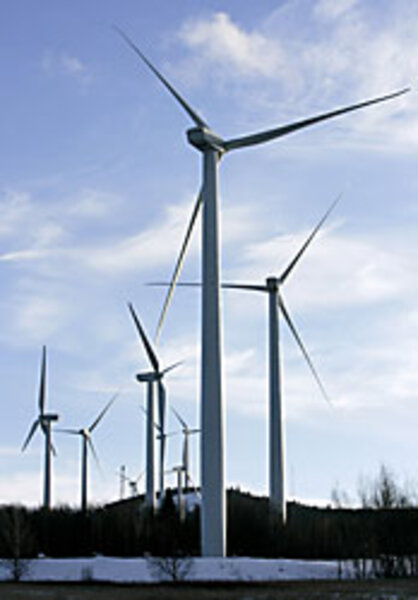All about windmills
Loading...
| Amsterdam
"Behold! A giant am I!" That's how Henry Wadsworth Longfellow's poem, "The Windmill," begins. Towering above us, the big arms (or blades) of the De Gooyer windmill hung motionless in the blue sky.
Once upon a time, those arms – often called sails – would have turned in the wind and helped power machinery to grind corn into meal. But now the windmill is a tourist attraction.
The world's first windmills may have been developed in Persia (modern-day Iran) more than 1,000 years ago. Over time, countries in Europe began to use them, too.
It's possible that the Netherlands wouldn't be the country it is today without these enormous structures.
Beginning in the 1200s, they were used to drain excess water from low-lying marshes and fens so that the Dutch people could live and work on the formerly wet ground.
When windmills were working at their peak – that is, when a good strong wind was blowing and the sails were turned to the wind – they were reported to be able to pump 10,000 gallons of water each minute into the canals that had been built to manage the water.
In the 1600s, the crankshaft and camshaft became popular in Europe. These technologies made the windmills useful for many more tasks.
A camshaft is a rod with many bumps along its length. It's connected with gears to the crankshaft, which turns it. This helps create a lifting motion.
With this technology, windmills could be used to help make paper and grind grain, cocoa, and spices.
They were also used to saw timber. Often the wood was used to help build Dutch ships that sailed off to trade in and colonize many lands, including what are today known as Indonesia, Taiwan, South Africa, Malaysia, and New York.
In fact, New York City was originally called New Amsterdam (or Nieuw Amsterdam in Dutch). The center of New York's city seal still shows the sails of a windmill.
The Netherlands had many different kinds of windmills. Because they were built to do different jobs, their appearance wasn't always the same.
One is the post mill. This is the oldest European type of windmill, possibly dating to the 1200s. It's square and rests on a center post. The post allows the whole structure to be turned to face the wind. Farmers could do this either by pushing a heavy beam, or by harnessing horses or oxen to do the work.
Smock mills, which can rise 60 feet or more in the air, look as though they are built on a platform. That's so they could rise above the trees and buildings that are near them and capture the wind.
Because only the tops of smock mills turn, the body of the mill could be made much larger to hold more millstones or machinery. That meant it could do more work than a post mill.
They were called "smock" mills because the body or main structure flares out like a smock, or coat worn by farmers.
The De Gooyer windmill dates back to the 1700s. It was moved near the center of Amsterdam in 1814, where it has stood ever since.
Windmills such as De Gooyer were moved or retired because the Netherlands turned to steam power and then to electricity as it industrialized. It no longer needed wind power.
One by one, the windmills fell out of use as the new motors took over their tasks. Once, about 10,000 windmills captured the breezes in the Netherlands and helped people work. By the early 1900s, more than 7,000 had been retired. Today, slightly more than 1,000 remain.
The good news is that in recent years people have taken an interest in restoring old windmills. Today, the windmills of the Netherlands are protected, and people can tour many of them.
For Americans, a special windmill to view would be De Schoolmeester, located in the province of North Holland. Built about 1692, it still functions as a paper mill today, and America's Declaration of Independence is thought to be written on paper produced by it!
Modern windmills and what they do
Many old windmills in the Netherlands and elsewhere may be only tourist attractions now, but more modern windmills around the world continue to do important work for people.
Wind pumps, once a fixture on the American plains, are still used on some farms in the United States to pump water from wells or other sources for drinking and irrigation.
Wind pumps also help provide drinking water to people in parts of eastern and southern Africa and Australia.
A special type of windmill, known as a wind turbine, turns wind energy into electricity that people can use to power their computers, TVs, and desk lamps.
Wind turbines are made of metal poles that look as though they have propellers of two or three blades on top.
The turbines soar 100 feet or more into the air and can be grouped together in "wind farms" to produce more power. The propeller turns a rotor, which is connected to a generator that makes the electricity.
Of course, when there's no wind, there's no electricity generated. And to some people, turbines spoil beautiful landscapes or ocean views.
Still, the wind is a good source of clean, renewable energy.
There will always be breezes blowing somewhere in the world, so wind won't run out as fossil fuels are forecast to. And unlike fossil fuels, wind turbines don't produce greenhouse gases that contribute to climate change.
The use of wind energy is on the rise, in part because of its environmental benefits. By 2012, the Global Wind Energy Council expects that wind power will grow by more than 155 percent.
• To learn more about wind power, go to www.eia.doe.gov/kids/energyfacts/sources/renewable/wind.html.
• To see how a wind turbine works, visit www1.eere.energy.gov/windandhydro/wind_how.html.
• For wind-inspired activities, visit the Science Museum of Minnesota online at www.smm.org/sln/vollis/trythese/trythese.html.






